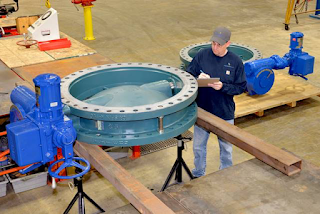 |
| 42 inch electrically (Limitorque) actuated butterfly valve. |
From simple, small pneumatic or electrically actuated valves, to very large, critical-control valve systems, Swanson Flo delivers tested, certified, and reliable product to customers located in the Upper Mid-West. Swanson Flo designs, engineers, and assembles actuated valve assemblies for the best fit, highest performance, and optimal application life. Their engineers and technicians combine decades of experience and knowledge. Coupled with a broad variety of carefully selected, readily available components, Swanson Flo customers are provided the best quality and best value possible.
Building upon 50+ years of industry and applications experience, Swanson Flo boasts the largest, most comprehensive automation facility in the mid-west, with capabilities for electric, pneumatic and electro-hydraulic actuation. A team of experienced design engineers and fabrication technicians construct automated valve systems from virtually any valve, actuator, monitor or positioner technology.
For more information, visit http://www.swansonflo.com or call 800-288-7926.


